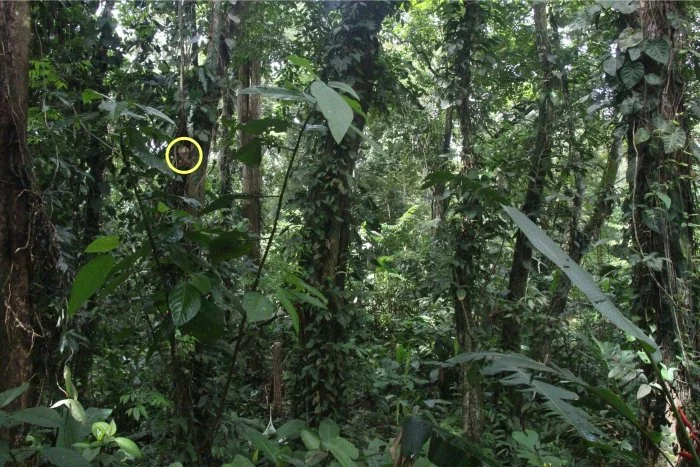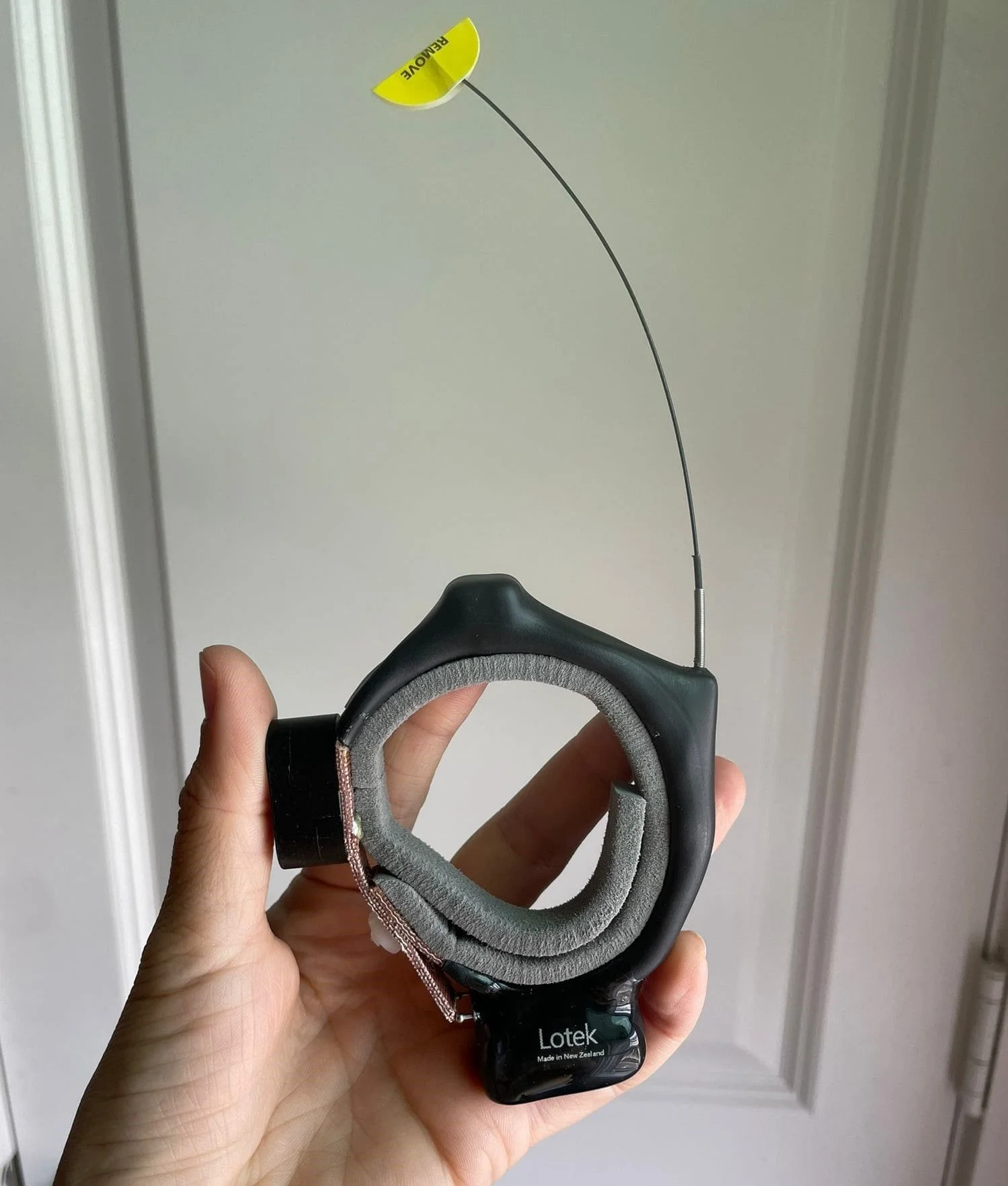Collars, Backpacks, and Data Loggers: How to study sloths in the Wild
One would think that due to sloths’ famously slow lifestyle, observing them in the wild would not be a hard task.
However, their slow lifestyle (a consequence of having the slowest metabolism of any land mammal) has resulted in the evolutionary aim of being nearly undetectable in the trees to avoid predation from Jaguars and Harpy Eagles.
A sloth sleeping, in the yellow circle.
So how do we scientists study these elusive creatures in their natural habitat?
Enter the Urban Sloth Project and cutting-edge tracking technology, which has been fine-tuned to the sloth's slow lifestyle. In this blog, we will delve into the world of VHF collars and Daily Diary Data Loggers, uncovering the invaluable insights they provide into the lives of sloths.
What is the Urban Sloth Project?
The Urban Sloth Project is a groundbreaking research initiative studying sloths inhabiting urban environments. This project aims to understand how sloths adapt to human-altered landscapes, providing crucial insights into their conservation and coexistence with urban development. The results of this research will help us and our colleagues improve and develop efficient and practical conservation strategies for sloths living in disturbed and fragmented habitats.
To collect data on sloth behavior, we use three devices: VHF collars, backpacks equipped with Data Loggers, and GPS collars.
The VHS and GPS collars allow us to locate the sloths and collect habitat data, which will be analyzed through geographic information system mapping GIS, and statistical tests. The behavior data collected by the Daily Diary Data Loggers (DDDL) is analyzed using specialized software (DDMT) at the Animal Movement Lab of Swansea University in Wales, UK.
The VHF collars
VHF (Very High Frequency) collars are tracking devices commonly used by scientists to monitor the movements and behaviors of animals. These lightweight and non-invasive collars are designed to fit comfortably around the sloth's neck, allowing researchers to track their whereabouts in real-time.
Equipped with specialized receivers, researchers track the radio signals emitted by the collars using an antenna, enabling them to locate and observe sloths within their study areas.
Are VHF collars uncomfortable/annoying for sloths?
VHF collars are carefully designed to ensure the comfort and safety of animals. Made from lightweight materials, these collars do not hinder their natural movements or behavior.
Researchers conduct extensive studies to determine the appropriate size and fit for each sloth, ensuring a snug yet non-restrictive fit. It is important to note that the collars are temporary and only used for a specific research period, causing no long-term discomfort or adverse effects on the sloths.
Sloth Backpacks
Although VHF collars are an effective way of locating sloths and collecting habitat data, they’re not the most effective way of collecting behavioral data.
For this, we use specialized Sloth Backpacks created and designed by SloCo founder Dr. Cliffe while working on her Ph.D. A Daily Diary Data Logger/micrologger (DDDL) is fitted inside the backpack, which must be totally water-resistant to protect the electrical components from the rain and humidity of the South Caribbean jungle.
A sloth named Baguette with a backpack. Photo: Suzi Eszterhas
In the early days of the Sloth Backpack designs (which were utilized for years before upgrading), the tech was put inside a condom and sealed within the contact cement. This ensured the backpack was watertight; however, it also meant that each backpack could only be used once.
Dr. Cliffe is fitting one of our old sloth backpacks. Photo: Suzi Eszterhas
Now, with help from engineers, the backpacks are 3D printed and made waterproof while being able to be taken apart and put back together, meaning these backpacks can be reused!
The latest version of our new sloth backpacks is 3D printed!
Daily Diary Data Loggers
The daily Diary Data Logger/micrologger (DDDL) is a small device equipped with various sensors that record 8 different parameters over 40 times a second (that's almost 28 million data points a day!), including body movement, activity, direction of travel, energy expenditure, altitude, temperature, and humidity.
Understanding and analyzing the data
Analyzing each data set is a complex task that requires understanding how to use software specifically designed to read the DDDL and statistical software to understand the significance of the data.
By examining the accelerometer data collected by the DDDL, we can determine the sloth's position and orientation, such as whether they are upside down or facing a particular direction. Additionally, the data loggers collect information on pressure, enabling us to ascertain whether the sloth is ascending or descending and their height in the tree at a given time. This data allows us to determine the height at which the sloth was located, as well as whether it was descending or ascending.
Ecology Coordinator Amelia Symeou is analyzing data at Swansea.
By observing wave patterns and figures derived from the accelerometer and pressure data, we can identify whether the sloth is stationary or engaged in movement. Each type of movement creates a distinct pattern in the figures and wave patterns, aiding us in understanding the sloth's activities more comprehensively. In most animals, these patterns will be quite rigid in their parameters; however, due to a sloth’s ability to maneuver in an indefinite number of ways, each behavior picked up in the software as fulfilling these parameters must be analyzed individually, which is a very time-consuming job. This information, combined with the collected GPS points and observational data, provides a great insight into the lives of urban sloths.
A case study: The Fall of Cacao
Cacao was a Hoffman’s two-fingered sloth (Choloepus hoffmanni) who was monitored at the start of the USP. In the following graphics, we’ll see 20 minutes in the life of Cacao, recorded by the DDDL in the backpack he wore for one month.
The red line on the top indicates pressure (the trace is inverted to make interpretation of the graph easier), while the colorful lines below indicate the position and orientation of the sloth from the accelerometer. In this sequence, we can determine that:
(1) The significant drop of the red line on the graphic shows a fall from a 15 m (45 ft) tree! As we have previously explained, sloths, thankfully, are adapted to survive falls like this.
(2) The accelerometry trace shows Cacao spins a little during the fall.
(3) The accelerometry and pressure traces both indicate Cacao lying still on the ground after he fell (all sloths do this for a few minutes after falling)
(4) This is Cacao rolling over from his back and onto his tummy, ready to crawl across the floor to climb the tree again
GPS collars
GPS collars are the latest technology that arrived to our hands. Although GPS collars have been widely used for many years, the size and weight of these devices were not suitable for sloths due to their large size and heavy weight until recently. New compact, lightweight devices have been designed which are perfect for sloths!
GPS collars combine Global Positioning System (GPS) technology with other sensors to collect valuable information about the animal's movements and behavior.
A sloth with a GPS collar.
The GPS component in the collar receives signals from satellites orbiting the Earth to determine the collar's precise location. This information is then stored in the collar's memory or transmitted in real time to a remote receiver or satellite system.
The importance of studying sloths
The Urban Sloth Project and innovative tracking technologies like VHF collars and Daily Diary Data Loggers have revolutionized our understanding of the lives of sloths in urban landscapes. By combining scientific research with conservation efforts, we can work towards ensuring these incredible creatures' long-term survival and coexistence. Through the ongoing efforts of dedicated researchers, we inch closer to unraveling the mysteries of sloth behavior and fostering a harmonious relationship between sloths and urban environments.
-Cecilia Pamich
Director of Communications & Outreach
-Amelia Symeou
Ecology Coordinator/USP


















